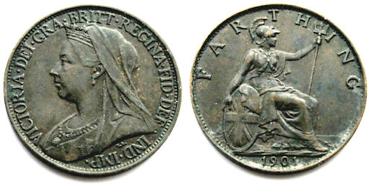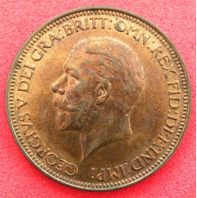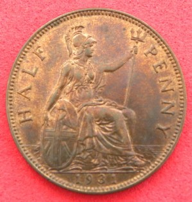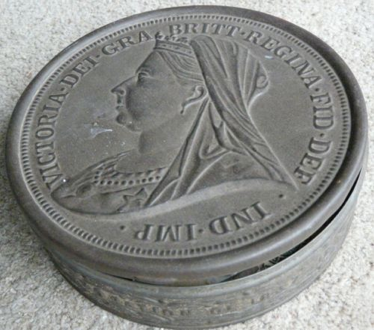The Cache in the Cairn
Owen Roberts
We read in Swallowdale following the successful ascent of Kanchenjunga, that Roger finds a box at the base of the cairn on the summit.
We also know from elsewhere that Kanchenjunga was the Swallows & Amazons name for mountain called the Old Man of Coniston. The Old Man of Coniston is the highest mountain in the Furness Fells and the seventh highest in England.
As well as the message inside, there was a Queen Victoria farthing (one quarter of an old penny) dated 1901.

|
|
1901 VICTORIA OH FARTHING
|
This farthing measures ¾ inch (20mm) across, so the picture is larger than reality, and is struck in bronze, much the same colour as the modern 1 penny piece. The OH in the description stands for Old Head. As the English monarch ages, every so often the head on the obverse of the coin is changed for one depicting the monarch in later life.
Although Queen Victoria died on the 22nd January 1901, all farthings with a 1901 date continued to bear her head. From 1902 the head of King Edward VII appeared on the obverse of the coin.
The farthing continued to be issued until 1956, with Britannia on the reverse being replaced by a wren in 1936/7 and ceased to be legal tender in 1960.

|

|
|
1931 GEORGE V HALF PENNY
|
This is an example of the bright halfpenny that Roger donated to place in the box when the message with the farthing was updated and replaced. The coin was 1 inch (25mm) across. The coin design was unchanged throughout the reign of George V. The halfpenny continued in use until 1969 with a change from Britannia on the reverse to Drake's ship, the Golden Hind, in 1937.
The coins and message were contained in a tin which celebrated the Diamond Jubilee of Queen Victoria. The tin below is an example of the many types of tin, with all kinds of contents, which were issued by manufacturers hoping to promote their sales in the Jubilee year.
The tin shown is NOT the same as the one described in SD. This was a small round brass box with the head of an old lady stamped on the lid. Framing the head of the old lady were big printed letters "QUEEN OF ENGLAND EMPRESS OF INDIA DIAMOND JUBILEE 1897".
This tin may have contained some sweets placed in it for the climb as it was in use 4 years after the date of issue. It could have been the type used to inter the coins and message in the cairn. Many commodities were tinned in those days and nearly every manufacturer produced a tin or other momento to commemorate the Queen's 60 year reign.
It is probable that the tin shown would have rusted during the time it was in the cairn if the water had penetrated the tinning protecting the steel container. A brass tin would have survived intact but probably covered in verdigris.
Incidentally, our current monarch, Queen Elizabeth II, will commemorate her own Diamond Jubilee this year in 2012.
Thanks to Adam Quinan for some information included in the above.
The search for an image of the exact type of brass tin goes on. The staff of the Museum of Lakeland Life & Industry have kindly searched fruitlessly in their archives. Perhaps an ATR reader can provide an image.
This article is ©2012 by Owen Roberts, and is posted on All Things Ransome with permission.
Back to the Literary Pages
Back to All Things Ransome




